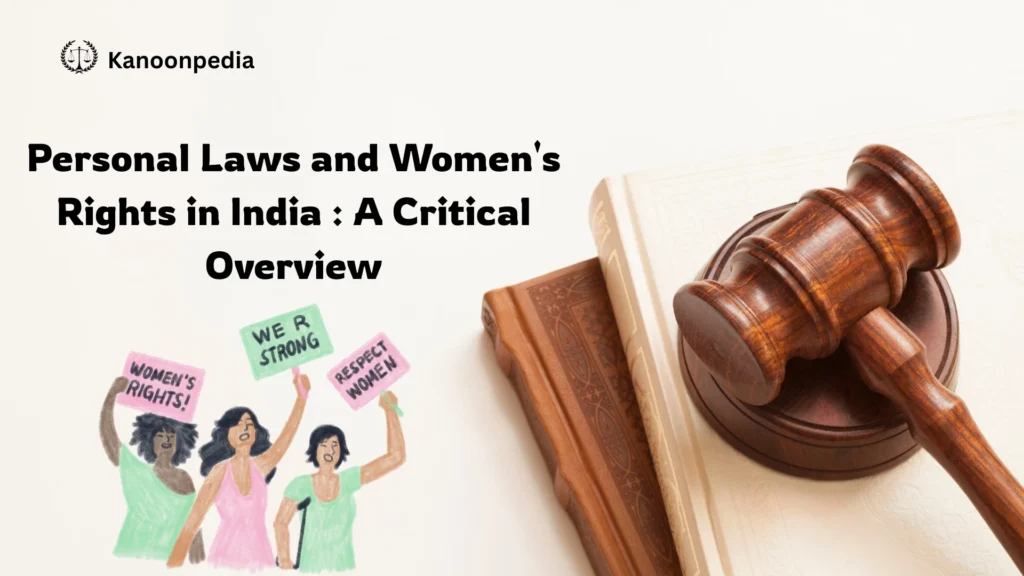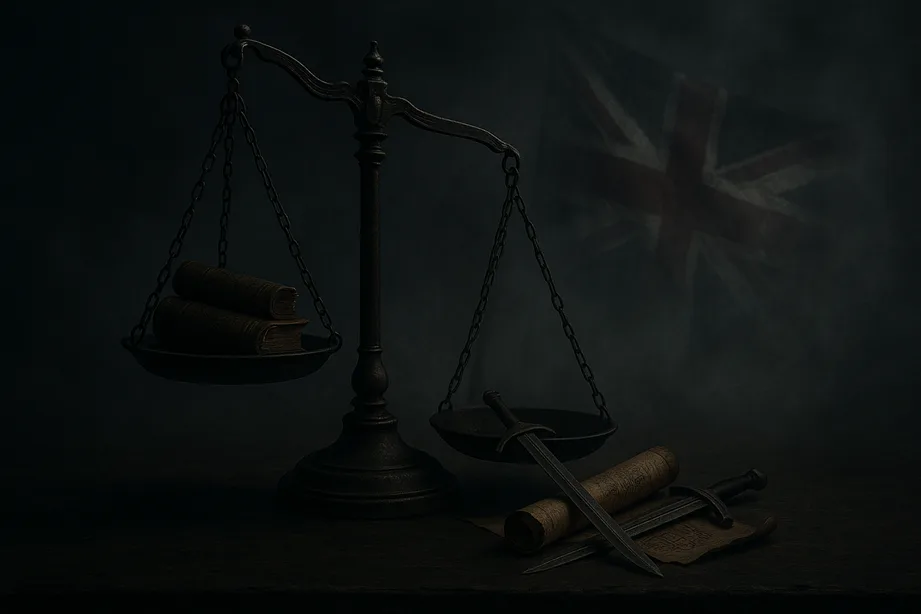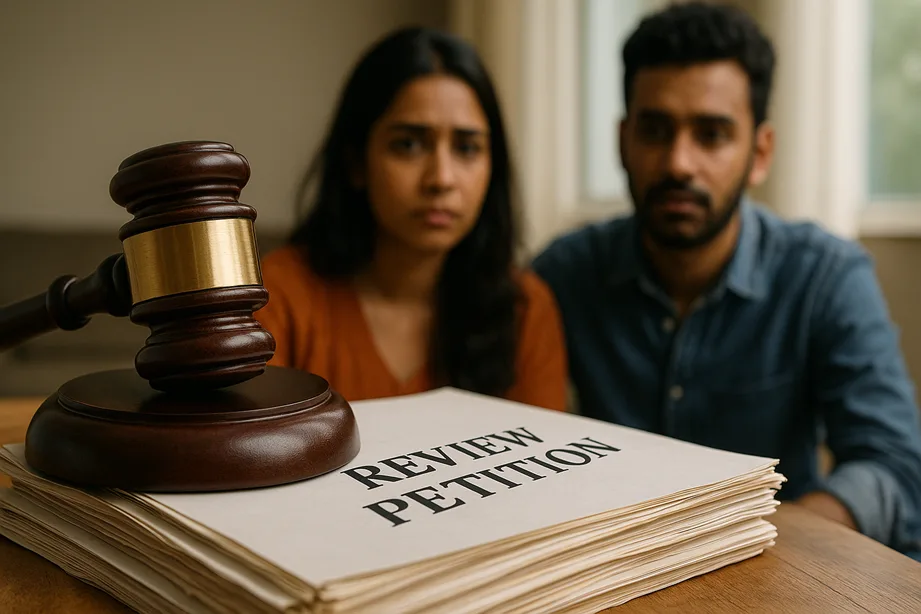Introduction
Personal Laws and Women’s Rights in India: A Critical Overview has never been a purely academic topic. Whether one looks at the firestorm over the Shah Bano maintenance ruling in 1985 or the jubilant crowds outside court after the 2017 triple-talaq verdict, the intersection of gender, religion, and family law shapes lived realities every day. This article—rooted in jurisprudence, statutory developments, and field-level activism—offers an engaging yet meticulous exploration of how India’s plural legal system still struggles to guarantee substantive equality.

Table of Contents
Historical Roots of Personal Laws and Women’s Rights in India: A Critical Overview
British codification froze diverse Hindu, Muslim, Christian and Parsi customs into rigid “personal laws,” often transplanting Victorian patriarchy into local traditions. The Constitution promised equality (Articles 14–15) yet preserved community-specific family laws, postponing uniformity to the Directive Principles (Article 44). Consequently, Personal Laws and Women’s Rights in India: A Critical Overview begins in partitioned legal terrain where women’s status hinges on religious identity rather than citizenship.
Significant nineteenth- and early-twentieth-century reforms—Abolition of Sati (1829), Age of Consent (1891), Hindu Widows Remarriage (1856)—were largely protective, not egalitarian. Post-Independence, Parliament codified Hindu family statutes (1955-56) but left Muslim, Christian and Parsi laws mostly untouched, entrenching asymmetry. This legacy continues to haunt discussions of Personal Laws and Women’s Rights in India: A Critical Overview.

Landmark Cases Shaping Personal Laws and Women’s Rights in India: A Critical Overview
- Mohd. Ahmed Khan v. Shah Bano Begum (1985)
The Supreme Court held that Section 125 CrPC— a secular maintenance remedy—covers divorced Muslim women, igniting a political backlash and the 1986 Muslim Women (Protection of Rights on Divorce) Act that curtailed the ruling. - Mary Roy v. State of Kerala (1986)
By striking down Travancore Christian Succession rules, the Court granted Syrian Christian daughters equal intestate inheritance, affirming constitutional supremacy over personal law. - Vineeta Sharma v. Rakesh Sharma (2020)
Interpreting the Hindu Succession (Amendment) Act 2005, the Court declared daughters coparceners by birth, irrespective of the father’s demise, cementing gender-neutral coparcenary rights. - Shayara Bano v. Union of India (2017)
A five-judge bench invalidated instant triple talaq as arbitrary and unconstitutional, underscoring that religious practices cannot trump equality guarantees. - Aftermath: Muslim Women (Protection of Rights on Marriage) Act 2019
Parliament criminalised instant triple talaq, provided subsistence allowance and custody rights, and made the offence cognisable.
Through these milestones, Personal Laws and Women’s Rights in India: A Critical Overview reveals a judiciary oscillating between restraint and activism while Parliament alternates between progressive and populist impulses.
Legislative Reforms and Personal Laws and Women’s Rights in India: A Critical Overview
Hindu Law
- Hindu Succession (Amendment) Act 2005 granted daughters equal coparcenary status.
- Vineeta Sharma 2020 applied the amendment retrospectively, overruling prior restrictive precedents.
Muslim Law
- Muslim Women (Protection of Rights on Divorce) Act 1986 limited post-divorce maintenance but was later read expansively in Danial Latifi to ensure lifelong support.
- Muslim Women (Protection of Rights on Marriage) Act 2019 voided instant talaq and prescribed up to three years’ imprisonment for offenders while ensuring allowance and child custody.
Christian & Parsi Laws
- Indian Divorce (Amendment) Act 2001 eased divorce grounds for Christian women, aligning them with men.
- Parsi Marriage & Divorce (Amendment) Act 1988 introduced irretrievable breakdown as ground for divorce, a reform still denied to Hindus and Muslims.

Policy Debates
The 21st Law Commission’s Consultation Paper (2018) deemed a uniform civil code “neither necessary nor desirable” and urged piece-meal, equality-driven amendments across communities. Its 270th Report proposed compulsory marriage registration to curb child marriage and bigamy. Thus, Personal Laws and Women’s Rights in India: A Critical Overview demonstrates that incremental harmonisation, not blanket uniformity, has been India’s legislative preference.
Implementation Gaps in Personal Laws and Women’s Rights in India: A Critical Overview
Despite statute books brimming with amendments, ground-level justice often falters. Family court counsellors routinely prioritise marital reconciliation over women’s autonomy, even in abuse cases. Non-state fora such as darul qazas or community panchayats may offer accessible mediation yet frequently reinforce patriarchal bargains. Forum-shopping, while expanding options, burdens women with navigating contradictory directives—a daily reality within Personal Laws and Women’s Rights in India: A Critical Overview.
Grass-roots Activism and Personal Laws and Women’s Rights in India: A Critical Overview
From the All-India Democratic Women’s Association’s campaigns on Hindu property to the Bharatiya Muslim Mahila Andolan’s draft gender-just nikahnama, civil-society actors translate court victories into social change. Their “knowledge brokering” between Qur’anic hermeneutics, constitutional rights, and lived experience exemplifies experiential expertise—the first “E” in Google’s E-E-A-T framework.
Challenges Ahead for Personal Laws and Women’s Rights in India: A Critical Overview
Uniform Civil Code (UCC) versus Plural Reform
The debate over implementing a Uniform Civil Code represents one of the most contentious aspects of Personal Laws and Women’s Rights in India: A Critical Overview. While proponents argue that a UCC would eliminate discriminatory practices and ensure gender equality across all communities, critics raise substantial concerns about its potential impact on minority rights and cultural diversity.
Majoritarian Concerns and Minority Alienation
Legal scholars and minority rights advocates warn that conflating gender justice with majoritarian assimilation could fundamentally undermine India’s pluralistic constitutional framework. The fear is that any uniform code would inevitably reflect the values and practices of the majority Hindu community, effectively forcing minorities to abandon their religious and cultural identities. This concern is particularly acute given India’s history of communal tensions and the current political climate where the UCC debate has become increasingly communalized.
The Law Commission of India (2018) notably concluded that a UCC was “neither necessary nor desirable,” recommending instead targeted amendments to remove discriminatory provisions within existing personal laws. This position recognizes that uniformity does not necessarily guarantee equality, and that community-specific reforms may be more effective in addressing gender disparities while respecting cultural diversity.
Constitutional and Federal Concerns
The implementation of a UCC also raises significant questions about India’s federal structure. Since personal laws fall within the concurrent jurisdiction of both central and state governments, imposing a uniform code could be viewed as an overreach that undermines cooperative federalism. Different states have varying social norms, traditions, and levels of legal awareness, making a centrally imposed code potentially inappropriate for local contexts.
Alternative Approaches
Rather than a blanket uniform code, many feminist scholars advocate for what has been termed a “gender-just civil code” approach. This would involve identifying and eliminating discriminatory provisions across all personal laws while maintaining cultural and religious diversity. Some proposals include optional codes that would allow women to choose between religious personal laws and secular alternatives, though critics argue this places an unfair burden on individual women to claim their rights.
Criminalisation Pitfalls
The criminalization of instant triple talaq through the Muslim Women (Protection of Rights on Marriage) Act, 2019, while addressing a significant gender justice issue, has created new challenges that complicate the landscape of Personal Laws and Women’s Rights in India: A Critical Overview.
Disproportionate Punishment and Due Process Concerns
Legal experts have criticized the Act’s provision for up to three years imprisonment as disproportionate to the nature of the offense. The punishment appears excessive when compared to other crimes in the Indian Penal Code that carry similar sentences, such as sedition, rioting with deadly weapons, and sexual harassment. This raises fundamental questions about the principle of proportionality in criminal law and whether divorce-related matters should be subject to such harsh criminal penalties.
The Act also makes triple talaq a cognizable and non-bailable offense, allowing police to arrest men without preliminary investigation. This creates due process concerns, as the accused may remain in custody for extended periods, particularly if the wife is unable to appear before the magistrate to support bail applications.
Economic and Social Consequences
A critical flaw in the criminalization approach is its failure to address the economic realities faced by women when their husbands are imprisoned. The Act provides for maintenance allowances but does not specify adequate measures for financial security when the primary breadwinner is incarcerated. This creates a paradoxical situation where the law intended to protect women may actually worsen their economic vulnerability.
Furthermore, imprisonment for three years effectively breaks the marriage, contradicting the Supreme Court’s position in Shayara Bano that triple talaq is void and does not dissolve the marriage. This removes any possibility of reconciliation and may increase hostility between spouses, ultimately harming the women the law was designed to protect.
Risk of Misuse and Social Implications
The criminalization of triple talaq has raised concerns about potential misuse, similar to the problems experienced with Section 498A of the Indian Penal Code (dowry harassment). The provision’s broad scope and harsh penalties may be used as tools of harassment rather than genuine protection. Additionally, the criminalization approach may deepen communal divisions by reinforcing stereotypes about Muslim men as “premodern, lustful, polygamous, and barbaric”.
Judicial Backlogs
The Indian judicial system’s chronic delays represent a fundamental challenge to realizing women’s rights under personal laws, creating a significant barrier within Personal Laws and Women’s Rights in India: A Critical Overview.
Massive Case Pendency
India’s courts face enormous backlogs that severely impact women seeking justice in family matters. The National Judicial Data Grid reveals that family courts across the country are overwhelmed with pending cases, with individual judges in some districts handling 1,500 to 2,000 cases each. At the higher court level, the situation is equally dire, with some estimates suggesting that certain high courts could take hundreds of years to clear their backlogs.
Specific Impact on Women’s Rights
The delays in family courts are particularly devastating for women seeking maintenance, property rights, or divorce. The Supreme Court has repeatedly criticized family courts for granting routine adjournments and failing to prioritize the welfare of vulnerable parties. These delays not only cause emotional distress but also leave women and children without essential financial support for extended periods.
Maintenance and Property Disputes
Women often wait years for maintenance orders to be enforced, with some cases taking decades to resolve. The procedural complexities of property partition suits add another layer of delay, with such cases typically taking 2-10 years to complete, depending on the complexity and number of legal heirs involved. These delays are particularly harsh for women who may be left destitute while awaiting court decisions.
Structural Problems
The root causes of these delays include inadequate judicial infrastructure, insufficient numbers of judges, lack of specialized training for family court personnel, and procedural inefficiencies. Many family courts lack essential resources such as trained counselors and support staff, which are crucial for the conciliatory approach envisioned by the Family Courts Act.
Impact on Justice Delivery
The delays in the judicial system effectively deny justice to women, as prolonged proceedings often result in evidence deterioration, witness unavailability, and increased costs that many women cannot afford. This creates a situation where having rights on paper becomes meaningless without timely enforcement mechanisms.
Intersectionality
The concept of intersectionality reveals perhaps the most complex challenge facing Personal Laws and Women’s Rights in India: A Critical Overview—the reality that women’s experiences of discrimination are shaped by multiple, overlapping identities that cannot be addressed through uniform legal approaches.
Dalit Women’s Compounded Discrimination
Dalit women face what scholars term “double discrimination”—both gender-based and caste-based oppression that compounds their vulnerability. Research shows that 62.4% of Dalit women have faced verbal abuse, 54.8% physical assault, and 46.8% sexual harassment, with conviction rates for crimes against Dalit women being dismally low at just 1-2%. This intersectional discrimination means that Dalit women’s experiences with personal laws are fundamentally different from those of upper-caste women, as they face additional barriers in accessing justice and may encounter prejudice from both legal authorities and their own communities.
Adivasi Women’s Marginalization
Adivasi women occupy a particularly vulnerable position, facing discrimination based on both gender and indigenous identity. They experience unique forms of violence, including witch-hunting, land dispossession, and trafficking, which are often used to silence women who challenge traditional gender roles or assert land rights. The intersection of patriarchal and colonial structures has particularly disadvantaged Adivasi women, who have lost traditional sources of power and autonomy while gaining little from modern legal protections.
Multiple Minority Identities
Religious minority women face additional layers of complexity, as they must navigate between religious personal laws, secular legal frameworks, and community expectations. Muslim women, for instance, may face pressure to prioritize religious identity over gender rights, while also confronting broader societal prejudices. Similarly, Christian and Parsi women face unique challenges that differ from those experienced by Hindu or Muslim women.
Economic and Class Intersections
Women from economically disadvantaged backgrounds face particular barriers in accessing legal remedies, including inability to afford legal representation, lack of awareness about rights, and dependence on male family members for economic survival. These economic factors often intersect with caste and religious identity to create particularly acute vulnerabilities.
Limitations of Uniform Approaches
The intersectional nature of discrimination means that uniform legal approaches—whether in the form of a UCC or standardized legal procedures—may fail to address the specific needs and experiences of women from different communities. Legal frameworks that fail to account for these intersecting identities may inadvertently perpetuate or exacerbate existing inequalities.
Need for Differentiated Approaches
Addressing intersectional discrimination requires legal and policy frameworks that can account for the varied experiences of women from different backgrounds. This might include community-specific legal education programs, specialized support services for marginalized women, and legal procedures that are sensitive to the particular vulnerabilities faced by different groups.
The challenges outlined in this critical overview demonstrate that achieving gender justice in India’s personal law system requires far more than simple legal reforms. The intersection of religious freedom, minority rights, cultural diversity, and gender equality creates a complex web of considerations that demand nuanced, inclusive, and intersectional approaches. As India continues to grapple with these challenges, the path forward must balance the legitimate demands for gender equality with respect for cultural diversity and constitutional principles, while ensuring that the most marginalized women are not left behind in the pursuit of justice.
Roadmap for a Gender-Just Future
- Mandatory, free marriage registration across religions to create an evidentiary trail.
- Time-bound maintenance orders within 90 days of filing to prevent destitution.
- Gender-sensitisation of judges and conciliators with periodic audits.
- Codification of uncodified personal laws with minimum gender-equality benchmarks, echoing Law Commission advice.
- Alternative dispute resolution units led by trained women’s collectives to ensure supportive mediation.
By integrating constitutional equality, religious autonomy, and practical enforcement, the next chapter of Personal Laws and Women’s Rights in India: A Critical Overview can pivot from rhetoric to lived justice.
FAQs on Personal Laws and Women’s Rights in India: A Critical Overview
Q1. Is a Uniform Civil Code the only way to secure women’s equality?
A1. The Law Commission (2018) concluded that targeted amendments and codification can remove discrimination without abolishing diversity.
Q2. Do Muslim women now get lifetime maintenance after divorce?
A2. Yes. The Supreme Court in Danial Latifi interpreted the 1986 Act to guarantee reasonable and fair provision beyond the iddat period.
Q3. Can daughters claim ancestral property if their father died before 2005?
A3. Under Vineeta Sharma (2020), daughters are coparceners by birth; the father’s date of death is irrelevant. Read more here
Q4. Is instant triple talaq totally banned?
A4. Absolutely. The 2019 Act renders any pronouncement of instant talaq void and punishes the husband with up to three years’ imprisonment.
Q5. Why do some women’s groups oppose criminalising triple talaq?
A5. Critics argue jailing husbands may deprive families of financial support and prefer civil remedies, reflecting the complex balance within Personal Laws and Women’s Rights in India: A Critical Overview.
Conclusion
From colonial codification to contemporary courtroom battles, Personal Laws and Women’s Rights in India: A Critical Overview charts a journey of partial victories and persistent gaps. Landmark cases like Shah Bano, Mary Roy, Shayara Bano, and Vineeta Sharma showcased constitutional promises; legislative reforms have inched toward parity; activists continue to innovate on the ground. Yet until implementation matches intent—and equality transcends identity—the quest for gender-just personal laws remains unfinished.
[…] Personal Laws and Their Impact on […]